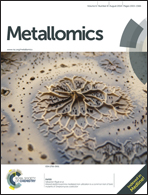Selected metal ions protect Bacillus subtilis biofilms from erosion†
Abstract
Many problems caused by bacterial biofilms can be traced back to their high resilience towards chemical perturbations and their extraordinary sturdiness towards mechanical forces. However, the molecular mechanisms that link the mechanical properties of a biofilm with the ability of bacteria to survive in different chemical environments remain enigmatic. Here, we study the erosion stability of Bacillus subtilis (B. subtilis) biofilms in the presence of different chemical environments. We find that these biofilms can utilize the absorption of certain metal ions such as Cu2+, Zn2+, Fe2+, Fe3+ and Al3+ into the biofilm matrix to avoid erosion by shear forces. Interestingly, many of these metal ions are toxic for planktonic B. subtilis bacteria. However, their toxic activity is suppressed when the ions are absorbed into the biofilm matrix. Our experiments clearly demonstrate that the biofilm matrix has to fulfill a dual function, i.e. regulating both the mechanical properties of the biofilm and providing a selective barrier towards toxic chemicals.


 Please wait while we load your content...
Please wait while we load your content...